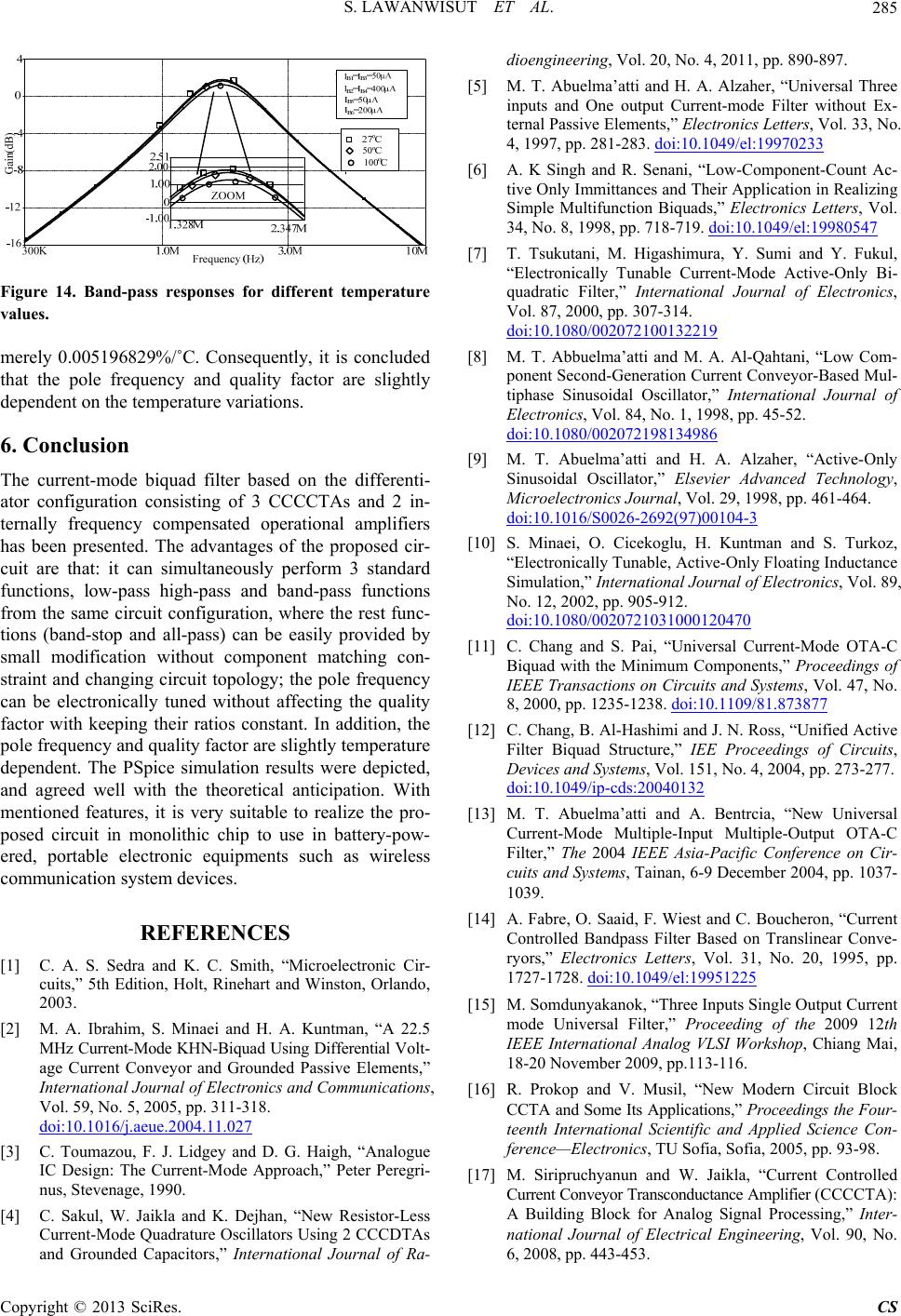
S. LAWANWISUT ET AL. 285
Figure 14. Band-pass responses for different temperature
values.
merely 0.005196829%/˚C. Consequently, it is concluded
that the pole frequency and quality factor are slightly
dependent on the temperature variations.
6. Conclusion
The current-mode biquad filter based on the differenti-
ator configuration consisting of 3 CCCCTAs and 2 in-
ternally frequency compensated operational amplifiers
has been presented. The advantages of the proposed cir-
cuit are that: it can simultaneously perform 3 standard
functions, low-pass high-pass and band-pass functions
from the same circuit configuration, where the rest func-
tions (band-stop and all-pass) can be easily provided by
small modification without component matching con-
straint and changing circuit topology; the pole frequency
can be electronically tuned without affecting the quality
factor with keeping their ratios constant. In addition, the
pole frequency and quality factor are slightly temperature
dependent. The PSpice simulation results were depicted,
and agreed well with the theoretical anticipation. With
mentioned features, it is very suitable to realize the pro-
posed circuit in monolithic chip to use in battery-pow-
ered, portable electronic equipments such as wireless
communication system devices.
REFERENCES
[1] C. A. S. Sedra and K. C. Smith, “Microelectronic Cir-
cuits,” 5th Edition, Holt, Rinehart and Winston, Orlando,
2003.
[2] M. A. Ibrahim, S. Minaei and H. A. Kuntman, “A 22.5
MHz Current-Mode KHN-Biquad Using Differential Volt-
age Current Conveyor and Grounded Passive Elements,”
International Journal of Electronics and Communications,
Vol. 59, No. 5, 2005, pp. 311-318.
doi:10.1016/j.aeue.2004.11.027
[3] C. Toumazou, F. J. Lidgey and D. G. Haigh, “Analogue
IC Design: The Current-Mode Approach,” Peter Peregri-
nus, Stevenage, 1990.
[4] C. Sakul, W. Jaikla and K. Dejhan, “New Resistor-Less
Current-Mode Quadrature Oscillators Using 2 CCCDTAs
and Grounded Capacitors,” International Journal of Ra-
dioengineering, Vol. 20, No. 4, 2011, pp. 890-897.
[5] M. T. Abuelma’atti and H. A. Alzaher, “Universal Three
inputs and One output Current-mode Filter without Ex-
ternal Passive Elements,” Electronics Letters, Vol. 33, No.
4, 1997, pp. 281-283. doi:10.1049/el:19970233
[6] A. K Singh and R. Senani, “Low-Component-Count Ac-
tive Only Immittances and Their Application in Realizing
Simple Multifunction Biquads,” Electronics Letters, Vol.
34, No. 8, 1998, pp. 718-719. doi:10.1049/el:19980547
[7] T. Tsukutani, M. Higashimura, Y. Sumi and Y. Fukul,
“Electronically Tunable Current-Mode Active-Only Bi-
quadratic Filter,” International Journal of Electronics,
Vol. 87, 2000, pp. 307-314.
doi:10.1080/002072100132219
[8] M. T. Abbuelma’atti and M. A. Al-Qahtani, “Low Com-
ponent Second-Generation Current Conveyor-Based Mul-
tiphase Sinusoidal Oscillator,” International Journal of
Electronics, Vol. 84, No. 1, 1998, pp. 45-52.
doi:10.1080/002072198134986
[9] M. T. Abuelma’atti and H. A. Alzaher, “Active-Only
Sinusoidal Oscillator,” Elsevier Advanced Technology,
Microelectronics Journal, Vol. 29, 1998, pp. 461-464.
doi:10.1016/S0026-2692(97)00104-3
[10] S. Minaei, O. Cicekoglu, H. Kuntman and S. Turkoz,
“Electronically Tunable, Active-Only Floating Inductance
Simulation,” International Journal of Electronics, Vol. 89,
No. 12, 2002, pp. 905-912.
doi:10.1080/0020721031000120470
[11] C. Chang and S. Pai, “Universal Current-Mode OTA-C
Biquad with the Minimum Components,” Proceedings of
IEEE Transactions on Circuits and Systems, Vol. 47, No.
8, 2000, pp. 1235-1238. doi:10.1109/81.873877
[12] C. Chang, B. Al-Hashimi and J. N. Ross, “Unified Active
Filter Biquad Structure,” IEE Proceedings of Circuits,
Devices and Systems, Vol. 151, No. 4, 2004, pp. 273-277.
doi:10.1049/ip-cds:20040132
[13] M. T. Abuelma’atti and A. Bentrcia, “New Universal
Current-Mode Multiple-Input Multiple-Output OTA-C
Filter,” The 2004 IEEE Asia-Pacific Conference on Cir-
cuits and Systems, Tainan, 6-9 December 2004, pp. 1037-
1039.
[14] A. Fabre, O. Saaid, F. Wiest and C. Boucheron, “Current
Controlled Bandpass Filter Based on Translinear Conve-
ryors,” Electronics Letters, Vol. 31, No. 20, 1995, pp.
1727-1728. doi:10.1049/el:19951225
[15] M. Somdunyakanok, “Three Inputs Single Output Current
mode Universal Filter,” Proceeding of the 2009 12th
IEEE International Analog VLSI Workshop, Chiang Mai,
18-20 November 2009, pp.113-116.
[16] R. Prokop and V. Musil, “New Modern Circuit Block
CCTA and Some Its Applications,” Proceedings the F our-
teenth International Scientific and Applied Science Con-
ference—Electronics, TU Sofia, Sofia, 2005, pp. 93-98.
[17] M. Siripruchyanun and W. Jaikla, “Current Controlled
Current Conveyor Transconductance Amplifier (CCCCTA):
A Building Block for Analog Signal Processing,” Inter-
national Journal of Electrical Engineering, Vol. 90, No.
6, 2008, pp. 443-453.
Copyright © 2013 SciRes. CS